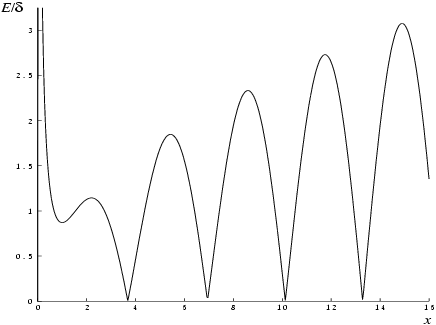s17ad returns the value of the Bessel function .
 Syntax
Syntax
| C# |
|---|
public static double s17ad( double x, out int ifail ) |
| Visual Basic |
|---|
Public Shared Function s17ad ( _ x As Double, _ <OutAttribute> ByRef ifail As Integer _ ) As Double |
| Visual C++ |
|---|
public: static double s17ad( double x, [OutAttribute] int% ifail ) |
| F# |
|---|
static member s17ad : x : float * ifail : int byref -> float |
Parameters
- x
- Type: System..::..DoubleOn entry: the argument of the function.Constraint: .
- ifail
- Type: System..::..Int32%On exit: unless the method detects an error or a warning has been flagged (see [Error Indicators and Warnings]).
Return Value
s17ad returns the value of the Bessel function .
 Description
Description
s17ad evaluates an approximation to the Bessel function of the second kind .
Note: is undefined for and the method will fail for such arguments.
The method is based on four Chebyshev expansions:
For ,
For ,
where ,
and , with .
For near zero, . This approximation is used when is sufficiently small for the result to be correct to machine precision. For extremely small , there is a danger of overflow in calculating and for such arguments the method will fail.
For very large , it becomes impossible to provide results with any reasonable accuracy (see [Accuracy]), hence the method fails. Such arguments contain insufficient information to determine the phase of oscillation of ; only the amplitude, , can be determined and this is returned on failure. The range for which this occurs is roughly related to machine precision; the method will fail if (see the Users' Note for your implementation for details).
 References
References
Abramowitz M and Stegun I A (1972) Handbook of Mathematical Functions (3rd Edition) Dover Publications
Clenshaw C W (1962) Chebyshev Series for Mathematical Functions Mathematical tables HMSO
 Error Indicators and Warnings
Error Indicators and Warnings
Errors or warnings detected by the method:
- x is too large. On failure the method returns the amplitude of the oscillation, .
- , is undefined. On failure the method returns zero.
- x is too close to zero, there is a danger of overflow. On failure, the method returns the value of at the smallest valid argument.
 Accuracy
Accuracy
Let be the relative error in the argument and be the absolute error in the result. (Since oscillates about zero, absolute error and not relative error is significant, except for very small .)
If is somewhat larger than the machine precision (e.g., if is due to data errors etc.), then and are approximately related by:
(provided is also within machine bounds). Figure 1 displays the behaviour of the amplification factor .
However, if is of the same order as machine precision, then rounding errors could make slightly larger than the above relation predicts.
For very small , absolute error becomes large, but the relative error in the result is of the same order as .
For very large , the above relation ceases to apply. In this region, . The amplitude can be calculated with reasonable accuracy for all , but cannot. If is written as where is an integer and , then is determined by only. If , cannot be determined with any accuracy at all. Thus if is greater than, or of the order of, the inverse of the machine precision, it is impossible to calculate the phase of and the method must fail.
 Parallelism and Performance
Parallelism and Performance
None.
 Further Comments
Further Comments
None.
 Example
Example
This example reads values of the argument from a file, evaluates the function at each value of and prints the results.
Example program (C#): s17ade.cs
